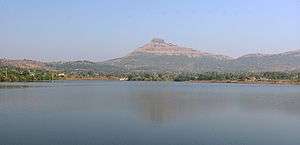Tikona
| Tikona | |
|---|---|
| तिकोना | |
| Maval | |
|
Tikona Fort near Pawna reservoir. | |
 Tikona | |
| Coordinates | 18°37′54″N 73°30′46″E / 18.6317°N 73.5128°E |
| Type | Fortress |
| Site information | |
| Open to the public | Yes |
| Condition | Ruined |
| Site history | |
| Materials | Stone and mortar |
Tikona (Marathi: तिकोना) also known as Vitandgad) is the dominant hill fort in Maval in western India. It is located near Kamshet around 60 km from Pune. The village nearest to the fort is called Tikona-Peth. The 3500 ft high hill is pyramidal in shape and the name Tikona means "triangle".
The fort is a trekking destination noted for the large doors, the temple of 'Trimbakeshwar Mahadev', a water tanks (seven water tanks) and some Satvahan caves. Trek organisers also commend the views of Pawna dam and the nearby forts of Tung, Lohagad and Visapur. There is Pawana lake at the summit. [1]
History

Little is known about the origins of this fort. There is a vihara on the fort datable to circa seventh-eight centuries A.D.[2] Malik Ahmad Nizam Shah I of the Nizam Shahi dynasty conquered the fort in 1585 and annexed it to the Nizam territory. In 1657, Shivaji Maharaj brought the whole of Konkan, which had been Nizam territory, under his control when he conquered Tikona along with the forts of Karnala, Lohgad, Mahuli, Songad, Tala, and Visapur. This fort was a strategic nexus: the centre of control for the entire Pawana Mawal region. In 1660, Dhamale family, the Deshmukhs from Maval region were charged with ensuring the security of fort Tikona. Jaysingh invaded the region in 1665 and attacked the local villages but the forts held out. Tikona fort was surrendered to the Mughal warrior Kubadkhan, who had attacked the region together with Halal Khan and others, according to the Treaty of Purandar signed on 12 June 1665. Kubad Khan took over the fort on 18 June but it was later recaptured by the Marathas.[3]
References
| Wikimedia Commons has media related to Tikona. |
- ↑ "for Tikona broadband".
- ↑ "Indian Archaeology 1969-70 - A review". p. 25. Archived from the original (PDF) on 24 July 2011. Retrieved 24 July 2011.
- ↑ "Tikona". Retrieved 24 July 2011.
